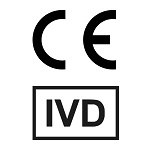Mouse anti Cytokeratin 7 / Keratin K7
Cat# MUB0316P-CE/IVD
Size : 0.1mg
Brand : Nordic Mubio
| Clone | OVTL12/30 |
| Isotype | IgG1 |
| Product Type | Primary Antibodies |
| Units | 0.1 mg |
| Host | Mouse |
| Species Reactivity | Human |
| Application | Flow Cytometry Immunocytochemistry Immunohistochemistry (frozen) Immunohistochemistry (paraffin) Western Blotting |
Background
Cytokeratins are a subfamily of intermediate filament proteins and are characterized by a remarkable biochemical diversity, represented in Human epithelial tissues by at least 20 different polypeptides. They range in molecular weight between 40 kDa and 68 kDa and isoelectric pH between 4.9 – 7.8. The individual Human Cytokeratins are numbered 1 to 20. The various epithelia in the Human body usually express Cytokeratins which are not only characteristic of the type of epithelium, but also related to the degree of maturation or differentiation within an epithelium. Cytokeratin subtype expression patterns are used in the distinction of different types of epithelial malignancies. The Cytokeratin antibodies are not only of assistance in the differential diagnosis of tumors using immunohistochemistry on tissue sections, but are also a useful tool in cytopathology and flow cytometric assays.
Source
OVTL12/30 is a Mouse monoclonal IgG1/κ antibody derived by fusion of SP2/0-Ag14 Mouse myeloma cells with spleen cells from a BALB/c Mouse immunized with a cytoskeletal preparation of OTN-11 ovarian carcinoma cell line.
Product
Each vial contains 100 ul 1 mg/ml purified monoclonal antibody in PBS containing 0.09% sodium azide.
Formulation: Each vial contains 100 ul 1 mg/ml purified monoclonal antibody in PBS containing 0.09% sodium azide.
Specificity
OVTL12/30 reacts exlcusively with Cytokeratin 7 which is present in specific glandular-type epithelia and most carcinomas derived thereof.
Applications
OVTL12/30 is effective on frozen tissue after fixation in methanol. It is particularly effective on paraffin-embedded tissue, for which pretreatment with e.g. 0.1% pronase / 0.1% trypsine in PBS or 0.5% pepsine in 0.01N HCl or microwave pretreatment is required. In addition, OVTL 12/30 is suitable for immunocytochemistry, immunoblotting and flow cytometry. Optimal antibody dilution should be determined by titration; recommended range is 1:100 – 1:200 for flow cytometry, and for immunohistochemistry with avidin-biotinylated Horseradish peroxidase complex (ABC) as detection reagent, and 1:100 – 1:1000 for immunoblotting applications.
Storage
The antibody is shipped at ambient temperature and may be stored at +4°C. For prolonged storage prepare appropriate aliquots and store at or below -20°C. Prior to use, an aliquot is thawed slowly in the dark at ambient temperature, spun down again and used to prepare working dilutions by adding sterile phosphate buffered saline (PBS, pH 7.2). Repeated thawing and freezing should be avoided. Working dilutions should be stored at +4°C, not refrozen, and preferably used the same day. If a slight precipitation occurs upon storage, this should be removed by centrifugation. It will not affect the performance or the concentration of the product.
Caution
When used for in vitro diagnostic purposes results must be put within the context of other diagnostic tests as well as the clinical history of the patient by a certified professional before final interpretation. Analyses performed with this antibody should be paralleled by positive and negative controls. If unexpected results are obtained which cannot be attributed to differences in laboratory procedures, please contact us. This product may contain hazardous ingredients. Please refer to the Safety Data Sheets (SDS) for additional information and proper handling procedures. Dispose product remainders according to local regulations.This datasheet is as accurate as reasonably achievable, but Nordic-MUbio accepts no liability for any inaccuracies or omissions in this information.
References
1. Ramaekers, F., van Niekerk, C., Poels, L., Schaafsma, E., Huijsmans, A., Robben, H., Schaart, G., and Vooijs, P. (1990). Use of monoclonal antibodies to Keratin 7 in the differential diagnosis of adenocarcinomas, Am J Pathol 136, 641-55. 2. van Niekerk, C. C., Jap, P. H., Ramaekers, F. C., van de Molengraft, F., and Poels, L. G. (1991). Immunohistochemical demonstration of Keratin 7 in routinely fixed paraffin-embedded Human tissues, J Pathol 165, 145-52. 3. van Niekerk, C. C., Boerman, O. C., Ramaekers, F. C., and Poels, L. G. (1991). Marker profile of different phases in the transition of normal Human ovarian epithelium to ovarian carcinomas, Am J Pathol 138, 455-63. 4. van de Molengraft, F. J., van Niekerk, C. C., Jap, P. H., and Poels, L. G. (1993). OV-TL 12/30 (Keratin 7 antibody) is a marker of glandular differentiation in lung cancer, Histopathology 22, 35-8. 5. van Niekerk, C. C., Vooijs, P., Casparie-van Velsen, I. J., and Poels, L. G. (1997). Differentiation margins of ovarian tumor pathology: first incidences of epithelial ovarian tumors monitored by marker antibodies, Cancer Detect Prev 21, 247-57. 6. Torenbeek, R., Lagendijk, J. H., Van Diest, P. J., Bril, H., van de Molengraft, F. J., and Meijer, C. J. (1998). Value of a panel of antibodies to identify the primary origin of adenocarcinomas presenting as bladder carcinoma, Histopathology 32, 20-7.
CE Mark
CE
Protein Reference(s)
Database Name: UniProt
Accession Number: P08729
Safety Datasheet(s) for this product:
 NM_Sodium Azide NM_Sodium Azide |

Figure 2. Immunohistochemistry of MUB0316P on paraffin section of human liver. Bile ducts are strongly positive.

Figure 3. Immunohistochemistry of MUB0316P on paraffin section of human breast. Positive staining of lobuli and ducti.

Figure 4: Frozen section of human kidney tissue immunostained with MUB0316, showing strong reactivity in the epithelial cells of the tubules.

Figure 7. MUB0316P (clone OVTL12-30) indirect immunofluorescence staining of a frozen section of human kidney at a 1:500x dilution. Note only strong reactivity in the epithelial ducts and no staning in connective tissue or glomeruli.

Figure 8. MUB0316P (clone OVTL12-30) indirect immunofluorescence staining of a frozen section of human kidney at a 1:500x dilution. Note only strong reactivity in the epithelial ducts and no staning in connective tissue or glomeruli.




